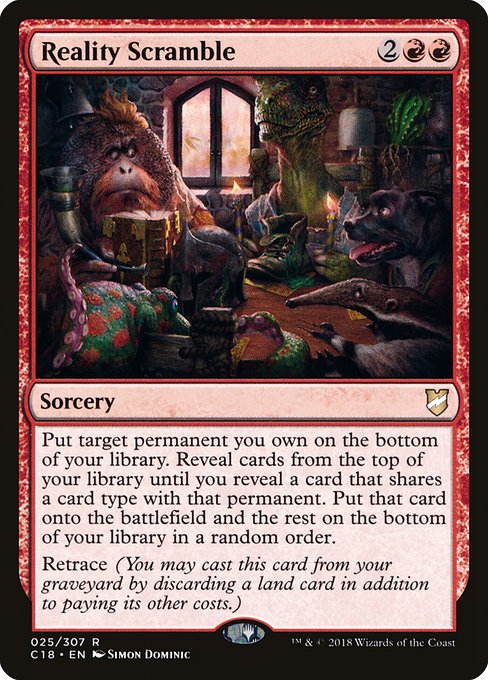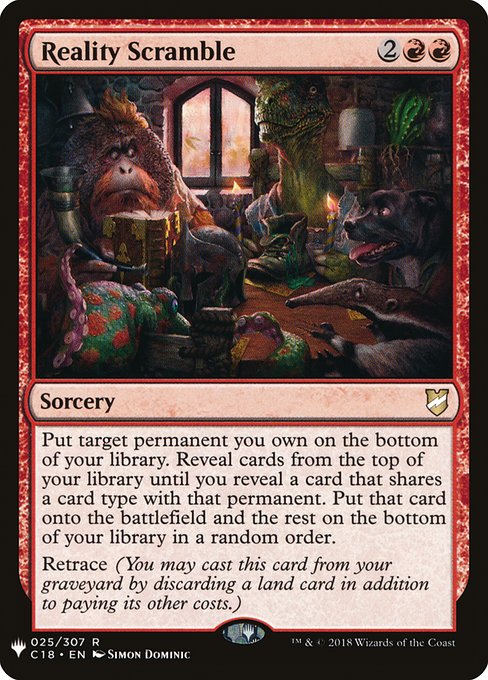Rimescolamento della Realtà
Stregoneria
Metti un permanente bersaglio che possiedi in fondo al tuo grimorio. Rivela carte dalla cima del tuo grimorio finché non riveli una carta che condivide un tipo di carta con quel permanente. Metti quella carta sul campo di battaglia e le altre in fondo al tuo grimorio in ordine casuale.
Rievocare (Puoi lanciare questa carta dal tuo cimitero scartando una carta terra oltre a pagare gli altri suoi costi.)
Rievocare (Puoi lanciare questa carta dal tuo cimitero scartando una carta terra oltre a pagare gli altri suoi costi.)
standard
future
historic
gladiator
pioneer
explorer
modern
legacy
pauper
vintage
penny
commander
brawl
alchemy
paupercommander
duel
oldschool
premodern
Rulings
In most cases, at least one card in your library (the card you put on the bottom of your library) will share a card type with the target permanent. However, in some unusual situations, no cards in your library share a card type with the permanent (perhaps because the permanent was a token or its types were changed). In that case, you’ll reveal your entire library, put nothing onto the battlefield, and put the cards back in a random order.
Casting a card with retrace from your graveyard follows the normal timing rules for its card type.
You’ll stop as soon as you reveal a card that shares any card types with the target permanent. For example, if the target permanent is an artifact creature, you’ll stop as soon as you reveal a card that’s an artifact or a creature.
Casting a card by using its retrace ability works just like casting any other spell, with two exceptions: You’re casting it from your graveyard rather than your hand, and you must discard a land card in addition to any other costs.
Reality Scramble can target any permanent you own, including those another player controls. A token’s owner is the player who created it.
The target permanent’s last known existence on the battlefield is checked to determine its types.
When a retrace card you cast from your graveyard resolves or is countered, it’s put back into your graveyard. You may use the retrace ability to cast it again. If it’s your turn, you may do so before any other player may take actions to try to remove it from your graveyard.
Casting a card with retrace from your graveyard follows the normal timing rules for its card type.
You’ll stop as soon as you reveal a card that shares any card types with the target permanent. For example, if the target permanent is an artifact creature, you’ll stop as soon as you reveal a card that’s an artifact or a creature.
Casting a card by using its retrace ability works just like casting any other spell, with two exceptions: You’re casting it from your graveyard rather than your hand, and you must discard a land card in addition to any other costs.
Reality Scramble can target any permanent you own, including those another player controls. A token’s owner is the player who created it.
The target permanent’s last known existence on the battlefield is checked to determine its types.
When a retrace card you cast from your graveyard resolves or is countered, it’s put back into your graveyard. You may use the retrace ability to cast it again. If it’s your turn, you may do so before any other player may take actions to try to remove it from your graveyard.
Rulings
In most cases, at least one card in your library (the card you put on the bottom of your library) will share a card type with the target permanent. However, in some unusual situations, no cards in your library share a card type with the permanent (perhaps because the permanent was a token or its types were changed). In that case, you’ll reveal your entire library, put nothing onto the battlefield, and put the cards back in a random order.
Casting a card with retrace from your graveyard follows the normal timing rules for its card type.
You’ll stop as soon as you reveal a card that shares any card types with the target permanent. For example, if the target permanent is an artifact creature, you’ll stop as soon as you reveal a card that’s an artifact or a creature.
Casting a card by using its retrace ability works just like casting any other spell, with two exceptions: You’re casting it from your graveyard rather than your hand, and you must discard a land card in addition to any other costs.
Reality Scramble can target any permanent you own, including those another player controls. A token’s owner is the player who created it.
The target permanent’s last known existence on the battlefield is checked to determine its types.
When a retrace card you cast from your graveyard resolves or is countered, it’s put back into your graveyard. You may use the retrace ability to cast it again. If it’s your turn, you may do so before any other player may take actions to try to remove it from your graveyard.
Casting a card with retrace from your graveyard follows the normal timing rules for its card type.
You’ll stop as soon as you reveal a card that shares any card types with the target permanent. For example, if the target permanent is an artifact creature, you’ll stop as soon as you reveal a card that’s an artifact or a creature.
Casting a card by using its retrace ability works just like casting any other spell, with two exceptions: You’re casting it from your graveyard rather than your hand, and you must discard a land card in addition to any other costs.
Reality Scramble can target any permanent you own, including those another player controls. A token’s owner is the player who created it.
The target permanent’s last known existence on the battlefield is checked to determine its types.
When a retrace card you cast from your graveyard resolves or is countered, it’s put back into your graveyard. You may use the retrace ability to cast it again. If it’s your turn, you may do so before any other player may take actions to try to remove it from your graveyard.
Your collection? Your decks?
Want to manage your collection and/or create decks?


 0
0
 0.29€
0.29€
